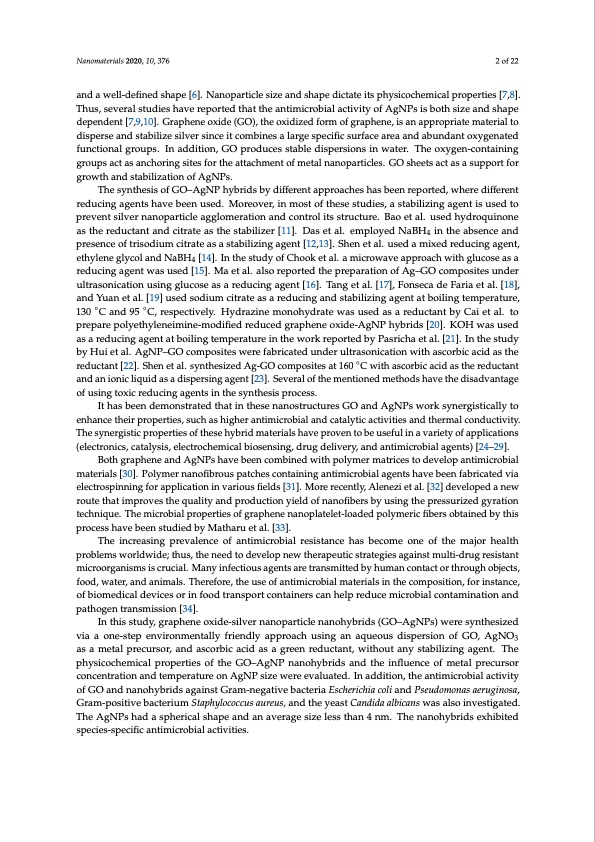
PDF Publication Title:
Text from PDF Page: 002
Nanomaterials 2020, 10, 376 2 of 22 and a well-defined shape [6]. Nanoparticle size and shape dictate its physicochemical properties [7,8]. Thus, several studies have reported that the antimicrobial activity of AgNPs is both size and shape dependent [7,9,10]. Graphene oxide (GO), the oxidized form of graphene, is an appropriate material to disperse and stabilize silver since it combines a large specific surface area and abundant oxygenated functional groups. In addition, GO produces stable dispersions in water. The oxygen-containing groups act as anchoring sites for the attachment of metal nanoparticles. GO sheets act as a support for growth and stabilization of AgNPs. The synthesis of GO–AgNP hybrids by different approaches has been reported, where different reducing agents have been used. Moreover, in most of these studies, a stabilizing agent is used to prevent silver nanoparticle agglomeration and control its structure. Bao et al. used hydroquinone as the reductant and citrate as the stabilizer [11]. Das et al. employed NaBH4 in the absence and presence of trisodium citrate as a stabilizing agent [12,13]. Shen et al. used a mixed reducing agent, ethylene glycol and NaBH4 [14]. In the study of Chook et al. a microwave approach with glucose as a reducing agent was used [15]. Ma et al. also reported the preparation of Ag–GO composites under ultrasonication using glucose as a reducing agent [16]. Tang et al. [17], Fonseca de Faria et al. [18], and Yuan et al. [19] used sodium citrate as a reducing and stabilizing agent at boiling temperature, 130 ◦C and 95 ◦C, respectively. Hydrazine monohydrate was used as a reductant by Cai et al. to prepare polyethyleneimine-modified reduced graphene oxide-AgNP hybrids [20]. KOH was used as a reducing agent at boiling temperature in the work reported by Pasricha et al. [21]. In the study by Hui et al. AgNP–GO composites were fabricated under ultrasonication with ascorbic acid as the reductant [22]. Shen et al. synthesized Ag-GO composites at 160 ◦C with ascorbic acid as the reductant and an ionic liquid as a dispersing agent [23]. Several of the mentioned methods have the disadvantage of using toxic reducing agents in the synthesis process. It has been demonstrated that in these nanostructures GO and AgNPs work synergistically to enhance their properties, such as higher antimicrobial and catalytic activities and thermal conductivity. The synergistic properties of these hybrid materials have proven to be useful in a variety of applications (electronics, catalysis, electrochemical biosensing, drug delivery, and antimicrobial agents) [24–29]. Both graphene and AgNPs have been combined with polymer matrices to develop antimicrobial materials [30]. Polymer nanofibrous patches containing antimicrobial agents have been fabricated via electrospinning for application in various fields [31]. More recently, Alenezi et al. [32] developed a new route that improves the quality and production yield of nanofibers by using the pressurized gyration technique. The microbial properties of graphene nanoplatelet-loaded polymeric fibers obtained by this process have been studied by Matharu et al. [33]. The increasing prevalence of antimicrobial resistance has become one of the major health problems worldwide; thus, the need to develop new therapeutic strategies against multi-drug resistant microorganisms is crucial. Many infectious agents are transmitted by human contact or through objects, food, water, and animals. Therefore, the use of antimicrobial materials in the composition, for instance, of biomedical devices or in food transport containers can help reduce microbial contamination and pathogen transmission [34]. In this study, graphene oxide-silver nanoparticle nanohybrids (GO–AgNPs) were synthesized via a one-step environmentally friendly approach using an aqueous dispersion of GO, AgNO3 as a metal precursor, and ascorbic acid as a green reductant, without any stabilizing agent. The physicochemical properties of the GO–AgNP nanohybrids and the influence of metal precursor concentration and temperature on AgNP size were evaluated. In addition, the antimicrobial activity of GO and nanohybrids against Gram-negative bacteria Escherichia coli and Pseudomonas aeruginosa, Gram-positive bacterium Staphylococcus aureus, and the yeast Candida albicans was also investigated. The AgNPs had a spherical shape and an average size less than 4 nm. The nanohybrids exhibited species-specific antimicrobial activities.PDF Image | Graphene Oxide–Silver Nanoparticle Nanohybrids

PDF Search Title:
Graphene Oxide–Silver Nanoparticle NanohybridsOriginal File Name Searched:
nanomaterials-10-00376.pdfDIY PDF Search: Google It | Yahoo | Bing
Turbine and System Plans CAD CAM: Special for this month, any plans are $10,000 for complete Cad/Cam blueprints. License is for one build. Try before you buy a production license. More Info
Waste Heat Power Technology: Organic Rankine Cycle uses waste heat to make electricity, shaft horsepower and cooling. More Info
All Turbine and System Products: Infinity Turbine ORD systems, turbine generator sets, build plans and more to use your waste heat from 30C to 100C. More Info
CO2 Phase Change Demonstrator: CO2 goes supercritical at 30 C. This is a experimental platform which you can use to demonstrate phase change with low heat. Includes integration area for small CO2 turbine, static generator, and more. This can also be used for a GTL Gas to Liquids experimental platform. More Info
Introducing the Infinity Turbine Products Infinity Turbine develops and builds systems for making power from waste heat. It also is working on innovative strategies for storing, making, and deploying energy. More Info
Need Strategy? Use our Consulting and analyst services Infinity Turbine LLC is pleased to announce its consulting and analyst services. We have worked in the renewable energy industry as a researcher, developing sales and markets, along with may inventions and innovations. More Info
Made in USA with Global Energy Millennial Web Engine These pages were made with the Global Energy Web PDF Engine using Filemaker (Claris) software.
Infinity Turbine Developing Spinning Disc Reactor SDR or Spinning Disc Reactors reduce processing time for liquid production of Silver Nanoparticles.
| CONTACT TEL: 608-238-6001 Email: greg@infinityturbine.com | RSS | AMP |